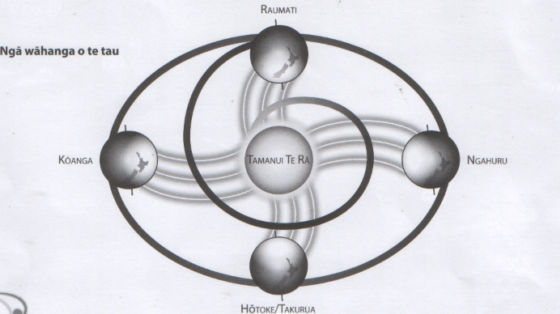He Rākau Ahau – He rotarota
Nā Hariata Green
| Tā te Māori aro atu ki tōna ao / Tirohanga Ao Māori | Māori World View |
|---|---|
|
|
Ngohe 1 (Activity One)
This activity expands on pūmahi (verbs) and pūingoa used in the rotarota.
Students are given the opportunity to:
1. Build on their vocabulary knowledge, in particular pūmahi and pūingoa.
2. Talk and listen to each other to construct sentences using pūmahi and pūingoa.
Hei Mahi 1: Teacher to start recording a list of pūmahi from the rotarota. As students are able they identify others both from the rotarota and any that are not – encourage this. Explain any that are new to the children.
Hei Mahi 2: Repeat same activity for pūingoa.
Hei Mahi 3: Record pūmahi as flash cards (1 word per card – all one colour). Do the same with pūingoa using a different colour.
Distribute cards to students so that they have a card (or selection of cards all of one type). Students talk to each other to find someone with whom they can construct a logical sentence using both of their cards.
Allow time for sharing.
Display and or record in some way, the sentences for students to refer back to.
Ngohe 2 (Activity Two)
This activity provides opportunities for students to:
- match text to appropriate illustrations
- explore the idea of seasons and cycles
- use kupu āhua to describe the appearance of Tāwhirimātea at different times of the year.
Teacher to provide students with text from each kōwai of the rotarota.
Teacher will also need to provide a time spiral (illustration where Tamanui-te-Rā is at the centre). Seasons spiral outwards from the centre with raumati being closest to Tamanui-te-Rā.

Hei Mahi 1: Students could either be provided with illustrations or asked to illustrate themselves, Ngā wāhanga o te Tau (seasons) around the spiral.
Hei Mahi 2: Get students to match the text from the rotarota to the appropriate illustration / place in the cycle.
Hei Mahi 3: Expand the concept of seasons of the year by using work produced from above tasks, to build a list of kupu āhua (adjectives) to describe how Tāwhirimātea would manifest himself for each of the seasons.
Hei Mahi 4: Use the adjectives from task 3 to reconstruct the verse on page 5. e.g. (Kia harikoa a Tāwhirimātea, ka pakari ōku peka, ka pīata ōku rau ka ora katoa tōku āhua.)
Ngā Hononga ki te Marautanga
| Ngā Āhuatanga o te Ākonga Kua māia ki te kōrero ki ngā tāngata katoa, ki ngā kaiako, ngā hoa, ngā mātua. Ka whakamahi i te reo kia hāngai ki te hunga whakarongo me te kaupapa. Ka whakamahi i te reo hei whakahoki whakaaro. Kua waia haere ki ngā momo tuhinga. Kua mōhio hoki he hua ka puta ki a ia i te tuhituhi. | ||
| Āheinga Reo: Ka tutuki te whānuitanga o ngā āheinga reo i roto i te wairua ngahau me te hiahia ki te whakawhitiwhiti whakaaro. | ||
| ā-Waha | ā-Tā | ā-Tinana |
| 1. Ka mārama ki ētahi kōrero āhua roa tonu. 2. Ka whakapuaki kōrero hei whakaputa māramatanga, tautohetohe rānei kia puta ai te reo whakakapi, te reo patapatai me te reo whakatau. | 1. Ka tautohu, ka tā i ngā tino āhuatanga o ngā momo reo tuhi, reo tā maha. 2. Ka pakari te tuhi me te tā i ngā momo reo tuhi me ngā reo ataata e taunga ana ia. | 1. Ka mārama ki te reo ā-tinana, ahakoa he ōpaki, he ōkawa rānei te horopaki. |
| Puna Reo: Ka tipu haere tonu te puna kupu me ōna āhuatanga katoa. | ||
| 3. Ka whakanikoniko i āna kōrero, tuhinga rānei ki ngā kupu taurite, kupu āhua nā te whānui haere o tana puna kupu. | 3. Ka tika te tātaki kupu hou ahakoa te horopaki. 4. Ka mārama ki ētahi kupu ake o tētahi kaupapa motuhake. | |
| Rautaki Reo: Ka whakamahi rautaki reo, ā, ka taea te whakamārama ngā huarahi kua whāia hei whakatutuki i tāna i whakaputa ai, i rongo ai. | ||
| 4. Ka mārama ki te anga o ngā momo kōrero Māori ake nei. | 5. Ka pānui wahangū, ā-waha rānei hei whakatutuki i ōna hiahia. 6. Ka whakamahi rautaki whānui ki te āta whakapūmau i te māramatanga o ngā tuhinga me ngā reo ataata maha. 7. Ka whakamahi i ētahi rautaki rangahau. 8. Ka whakamahi mahere hei whakatakoto, hei whakaraupapa i ngā whakaaro. 9. Ka whakatika i āna hapa tuhi me te āhua o te whakatakoto whakaaro kia mārama ake ai te tuhinga. 10. Ka whaihua ake āna tuhinga i te noho raupapa mai o ngā whakaaro i roto i ngā kōwae me te whakamahi tohu tuhituhi. | 2. Ka hāngai te reo ā-waha, ā-tinana ki te kaupapa o te kōrero. |




